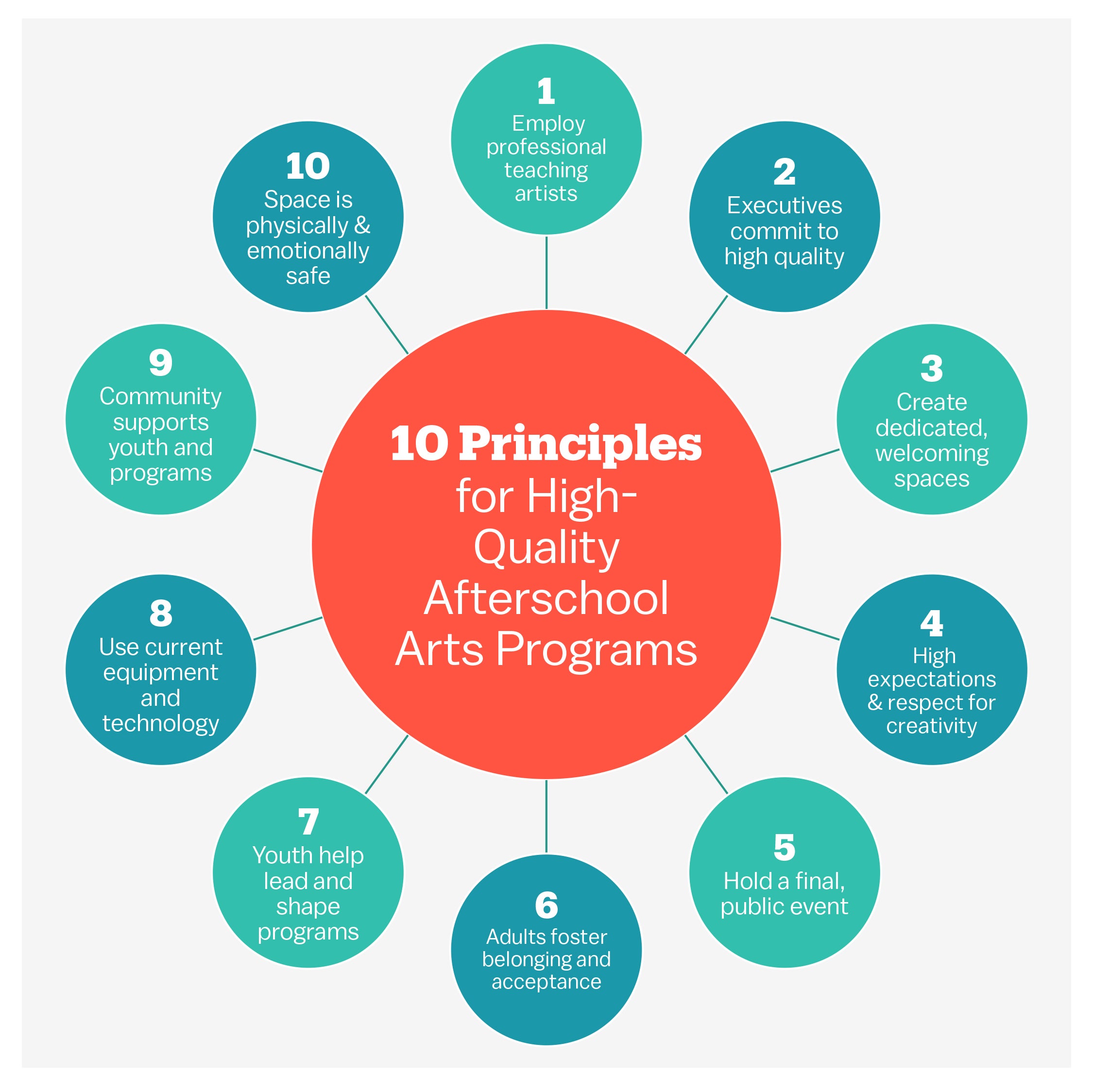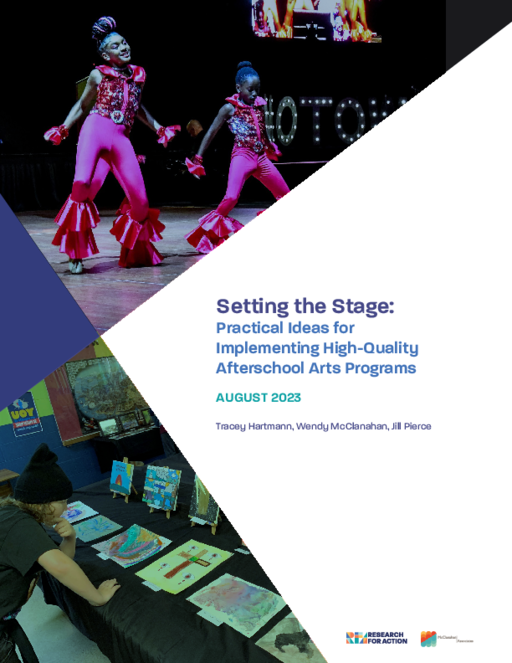Breadcrumb
- Wallace
- Reports
- Setting The Stage Practical Idea...
Setting the Stage
Practical Ideas for Implementing High-Quality Afterschool Arts Programs

- Author(s)
- Tracey A. Hartmann, Wendy S. McClanahan, and Jill Pierce
- Publisher(s)
- Research for Action and McClanahan Associates
Summary
How we did this
The lessons shared in this report draw on multiple sources of data collected during two and a half years of the research, including over 300 interviews and 42 program observations. Interview, focus group, and observational data were coded and analyzed each year of the study.
Afterschool programs looking to add high-quality arts learning to their programming might do well to keep three practices in mind:
- Employ professional teaching artists
- Provide current, high-quality equipment
- Create dedicated art spaces that welcome and inspire
These practices are essential to enriching arts experiences that engage young people. They may entail higher costs than what an organization currently spends on arts programs. But these costs may not be vastly different from the costs of sports, STEM, or other programs.
And there are ways to keep the costs down.
These are the major findings from research about a Wallace Foundation effort that sought to increase access to high-quality arts education for students from historically marginalized backgrounds. The Youth Arts Initiative (YAI) operated out of the Boys & Girls Clubs of America (BGCA), a network of more than 4,000 clubhouses across the United States. Given this reach, the idea was for YAI to help expand arts learning to more young people who might otherwise not have access to it.
Five clubs began arts-learning programs based on 10 key principles of high-quality arts programming. These principles emerged in research that included interviews with young people and practitioners running leading, stand-alone youth arts programs. BGCA clubhouses offer a range of non-arts programs for young people. They wanted to see if they could incorporate first-rate arts programs into their own structures and budgets, too.
An earlier wave of the initiative had focused on six BGCA clubhouses in the Midwest. Two reports from that wave found that all six clubs had succeeded in introducing arts programs that followed the 10 principles, and that youth found value in the programs. But costs were high, and Wallace had provided an initial infusion of capital to help start and run those programs.
In the second wave of YAI, clubs tested whether they could expand the programs for less money. The hope was that lower costs would mean the clubhouses could deliver high-quality arts to more young people and sustain operations over time.
The bottom line of the two initiatives: high-quality arts programs do take money to run well. But there are ways to help reduce costs. In fact, several promising practices emerged, and this report covers some of what worked for the five clubs studied–and what did not.
Lessons Learned
The Covid-19 pandemic threw a curveball into the clubhouses’ work. Still, all five kept classes running, online and in-person. The researchers were able to glean “early lessons” in what it takes to run a high-quality arts program within the resource constraints of a large, multi-service youth organization.
They also learned which of the ten principles were critical for success, especially for organizations with tight budgets.
Through more than 300 interviews and 42 program observations from 2019 to 2021, the researchers found that clubs focused on adapting three of the ten principles. These proved to be the most resource-intensive but also the most important for increasing the quality of arts programming.
- Investing in professional, practicing teaching artists was essential for all clubs, because the artists were critical to implementing many of the other key principles for success.
- Offering up-to-date, high-quality equipment and materials was vital for engaging young people, but researchers found that having these resources mattered more for some arts disciplines than others.
- Creating welcoming and inspiring art spaces was a structural challenge for many of the clubs, which did not have dedicated art spaces.
Each of the three presented considerations for the budget-minded. For example, through their skills and connections with students, teaching artists could help ensure quality even when inspiring arts spaces or the latest equipment were lacking. Another example: The art form chosen by the organization influenced the cost of equipment. Visual, digital, and some performing arts required substantial investment in gear, but dance did not. At the same time, dance may require an investment in space, such as proper flooring.
Promising Approaches
The report also offers ideas for keeping costs in check. To mention a few:
- Teaching artists: Organizations could employ early career teaching artists as well as longtime professionals
- Equipment: Organizations could seek donations of new equipment and materials after engaging industry partners in the relevant art form
- Dedicated spaces: Organizations could form partnerships to use the spaces at community arts organizations or other institutions
The report also discusses some of the tradeoffs clubs made to actively implement the three foundational principles, and it addresses potential implications for equity and for broadening access to arts learning.
A quick summary chart of the promising approaches some of the clubs implemented is attached here as a download and can be found in the executive summary of the report itself.
The researchers are hopeful that their work can help highlight ways for other organizations to expand their infrastructure and operate high-quality arts programs, especially in a low-cost setting.

Youth from families with low incomes are about half as likely to have access to arts instruction as youth from families with more resources.
Visualizations

The 10 principles for running high-quality afterschool programs were based on the experiences of effective programs and outlined in Something to Say.
Key Takeaways
- High-quality arts programming requires a continued investment in resources. While there are strategies for making quality choices while spending less, these could require trade-offs and have implications for broader access.
- Investing in teaching artists, current equipment, and dedicated space can be the most costly aspects of a high-quality program, but they can also offer the most rewards for students.
- Teaching artists with youth development skills are, perhaps, the most essential factor in quality, as they can help ensure that other principles of successful programming are achieved.
- Access to high-quality studio space can be a big challenge for organizations with small budgets and can raise equity issues in terms of how and which students are able to access a particular program.
- Partnering with community arts organizations can be a useful way to expand access to teaching artists, spaces, and equipment.
Materials & Downloads
What We Don't Know
- How might organizations and programs without the backing of a large, centralized organization like the Boys & Girls clubs adapt some of the foundational practices identified?

